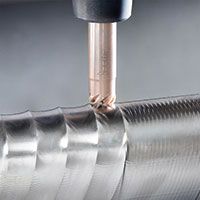by Andrei Petrilin
Tool accuracy plays an integral role in high speed machining success
High cutting speed is a natural attribute of high speed machining (HSM). In recent years, the issue of tool accuracy has become an additional point to consider. What is the reason? Why is high speed machining penetrating more and more into rough processing? How
do cutting tool producers formulate their solutions to meet these new industrial demands?
Accurate machining means maintaining repeatable strict tolerances during cutting operations. Just how strict that is depends on the machining method, for example: milling, turning, or drilling, and the type of operation: rough, semi-finish or finish.
Usually, HSM relates to cutting by rotating tools – mainly milling cutters. In many cases, when a part featuring complex profiles and slots is produced from a solid material, HSM provides productive low-loaded roughing by trochoidal milling.
According to this technique, a rapidly rotating milling cutter moves along a complicated trajectory and slices thin but wide layers of the material. This results in pre-shaping the part very close to a final form. The remaining small allowance is removed in the next stage: high speed finish milling. Producing blisks (bladed discs) and impellers is a typical example of the mentioned process that may be defined by the rather oxymoronic term: “accurate roughing.”
 high speed machining relies on a key element chain comprising a machine tool, an effective machining strategy,
high speed machining relies on a key element chain comprising a machine tool, an effective machining strategy,
proper toolholding, and a cutting tool. The low-power multi-axis machine tools designed especially for HSM feature high torque characteristics, high velocity drives, effective controllers and intelligent software. They are capable of realizing various machining strategies which were developed for ensuring maximum efficiency.
Today, metalworking has in its arsenal highly reliable toolholders designed for secure tool mounting in an expanded range of rotational speeds. Under such conditions the cutting tool – the element that directly contacts a machined part during a cutting operation – can be a limiting factor in maximizing the potential of advanced machine tools. This element is much smaller and less complicated compared to machine tools and holders
Each improvement in the last chain element – the cutting tool – may be crucial. The cutting tool industry is far from stagnation; the branch is on the constant move in developing new solutions to meet the demands of changing metalworking technologies.
Time has not radically changed principal tool requirements: it is expected to be more durable and more efficient when cutting at considerably increased cutting speeds and feed rates. Lowering machining allowances leads to additional tightening tool accuracy parameters.
An ideal product is a precise and high-balanced tool that ensures high performance in combination with excellent tool life when cutting at high rotational speeds.
More flutes, less vibrations
Multi-flute solid carbide endmills were developed especially for vibration-free high speed machining operations. Their design features a varying helix angle, variable tooth pitch and a specially shaped chip gullet, intended for applications such as semi-finish and finish high speed milling, as well as roughing by trochoidal technique.
 A new geometry available integrates chip splitting grooves in the endmill design. The geometry has an unusual appearance because HSM forms thin chips that do not appear to need an additional chip splitting action. However, the grooves increase vibration resistance and reduce cutting forces, significantly improving trochoidal milling and machining performance at high overhangs. In trochoidal milling, the produced chips are thin but wide. Splitting the chips into narrower segments contributes to better chip evacuation and surface finish, which increases accuracy and effectiveness in rough high speed machining.
A new geometry available integrates chip splitting grooves in the endmill design. The geometry has an unusual appearance because HSM forms thin chips that do not appear to need an additional chip splitting action. However, the grooves increase vibration resistance and reduce cutting forces, significantly improving trochoidal milling and machining performance at high overhangs. In trochoidal milling, the produced chips are thin but wide. Splitting the chips into narrower segments contributes to better chip evacuation and surface finish, which increases accuracy and effectiveness in rough high speed machining.
Ceramics that cut fast
Milling difficult-to-cut high temperature superalloys (HTSA) by carbide tools necessitates low cutting speeds, normally 20-40 m/min (65-130 sfm). High speed machining with a small radial engagement, when the width of cut is up to 10 per cent of a mill diameter, usually features cutting speeds of 70-80 m/min (230-265 sfm). The metalworking industry is always seeking ways to increase productivity when manufacturing parts from HTSA; and low cutting speed is one of the existing barriers to this goal. A solution may be found in applying cutting ceramics as a tool material for high speed machining.
Long-reach high speed milling operations require tools with long overall length. A solid tool concept is not an economically attractive option. An assembled cutter comprising a body carrying a carbide cutting head is a solution that makes economic sense.
A wet coolant may be a means for upgrading machine tools from low velocity to high speed.
Changing technologies require new machining concepts: more productive, more economical, more sustainable. High speed machining has already proved itself as a method that meets today’s industrial needs. The progress in producing workpieces by non-machining processes brings in focus low-power high speed roughing. Accordingly, cutting tool manufacturers already feel the growing demands for appropriate products.
It is a definite trend, which, no doubt, should be considered. SMT
Andrei Petrilin is a technical manger for Iscar.
